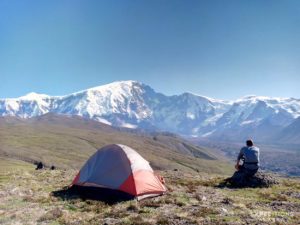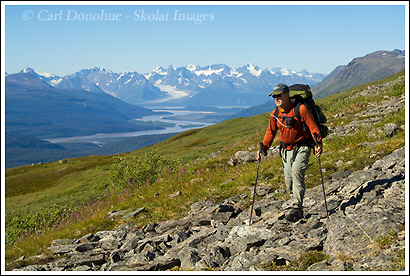Hey Folks
I’ll talk here briefly about one of the issues people seem to have backpacking in Alaska. Sure, trips can be strenuous and hard in terms of endurance and cardiovascular fitness, but a more common issue for people is hiking over uneven terrain. For those folks who are used to backpacking and hiking on trails, such as in the Lower 48, the trailless mountains of Alaska pose a new challenge.
One of the things some people struggle with is hiking over a moraine, or a talus slope, like this one here. A moraine is a glacial formed pile of rocks. Sometimes, that pile might be huge, miles across. Sometimes it’s much smaller.
A talus slope, such as this one overlooking the Bremner River near where it joins up with the Copper River in the Chugach Mountains, Wrangell St. Elias National Park, is usually formed by a rock slide. Talus and scree are actually the same thing, but talus usually is used to refer to larger rocks, and scree smaller stones. They’re often unstable, because they’re on steep terrain, and that alone is problematic. It also is simply hard for people to walk over very uneven footing, such as rocks and boulders.
Usually, what happens is called ‘frost heaving’, where, during warmer times, water seeps into the ground, and into rock. Then as temperatures decrease, such as at nighttime, the water freezes, and the ice expands. This cracks the rock open, kind of like a wedge might. This cracking the rocks open leads to erosion, and the rocks becomes slides and scree or talus slopes are formed. Most scree and talus slopes are the product of this process.
All I can suggest is practice. The more you do it, the easier it gets. And be careful. It’s easy to hurt yourself on rocks – they can be REALLY unforgiving.
Hiking poles are very helpful, some people use 2, but some people just use 1. I prefer one, but it’s something you need to try and feel for yourself what you’re most comfortable with. They really do make a big difference.
Also, as is so often the case, go slowly, take small steps, and pay attention to your footing. Don’t lift your back foot until you know the front one is stable. And try to tread lightly (hard when you have 50 pounds on your back, obviously!).
Gradually, like any activity, your confidence increases, and you’ll find that’s 90% of the battle right there. Skiing or mountain biking is similar, I think. The technique is really somewhat rudimentary, but the confidence is the deciding factor for most people.
If it’s been raining, and the talus is wet be REALLY careful. Those rock edges can awfully slippery in a drizzle. I’d try to go around them when possible if they’re wet.
Packing your backpack correctly will also make a difference to your balance, and we’ll go through that conversation in another post. Learning good balance can take time, but it’s one of those things that will improve if you work on it. So get out there, get off the trail, and scramble around a little. Obviously don’t go crazy, and hurt yourself, and don’t go off-trail where it’s important you stay ON the trail, but with a little common sense, I’m sure you’ll understand what I mean.
I’m heading out in the morning to do some exploring, so maybe I’ll do some practice myself.
Cheers
Carl




